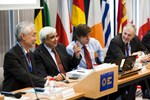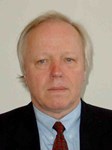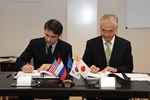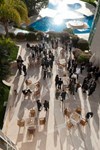At its recent meeting, the ITER Council approved the appointment of Remmelt Haange as Deputy Director-General and Head of the ITER Project Department. "Rem," as people call him, is a very experienced fusion engineer. He worked on JET for more than 15 years and led the ITER team in Naka, Japan, for many years before he became Technical Director of the W7-X Stellerator project based in Greifswald, Germany. He is thus very familiar with the challenges of fusion technology as such and the challenges of managing a fusion project. And because he truly believes in fusion as "the only alternative" he has decided to join the ITER management rather than think about his retirement.
After studying and achieving his degrees at the German Technical University in Aachen, the Dutch-born nuclear engineer moved to the UK to work on the Dragon Project, a high temperature nuclear reactor project based in Winfrith, Dorset and supported by the Organization for Economic Co-operation and Development (OECD). From 1976 until 1979, he established a group of engineers and metallurgists within the multi-national High Temperature Materials Program in Wimborne, Dorset.
Later he became leader of the design group for JET's neutral injection beamline. In 1987, he took over JET's Fusion Technology Division and in 1992 he was appointed Deputy Head of the Torus and Measurements Department and also Shutdown Manager.
In 1993, he and his wife moved across the globe to Japan where he headed ITER's Nuclear Technology Divison at the Naka Joint Worksite. He was appointed Head of Site in 2003. Then, in July 2005, Rem was called back to Germany to lead the technical development of the Wendelstein project—which at that time was going through a difficult phase with very similar problems to what ITER is facing at the moment. "So I do have some experience in managing challenging situations and I guess that is why I am here," Rem says.
The challenges that lie ahead are "enormous and complicated" Rem stresses, "but they are not unsolvable if we all pull on the same string. The Baseline is approved and so the goals are defined. We now have to make sure that we meet these milestones. This fascinating, world-spanning project must become a success. There is no alternative to fusion."
Rem will take up his duties on 17 January 2011.
Over two years ago, Newsline reported on efforts by the Design Office to streamline design activities between the ITER Organization and the seven Domestic Agencies. The streamlining efforts were undertaken in an effort to meet Procurement Arrangement schedules in the timeliest manner. "The ideal," says Eric Martin, Head of the ITER Design Office, "is to have a global design office ..." incorporating dedicated design teams assigned by each Domestic Agency that are available to work—in real time—on the same projects as their ITER counterparts."
Excellent progress has been made toward this goal so far. This week, streamlining efforts took another big step forward as representatives from the ITER Design Office met with their professional counterparts from the seven Member states at the Korean Domestic Agency in Daejeon in order to discuss how to improve ITER worldwide collaboration.
"The timing of this meeting has been quite opportune," Eric Martin reports, "enabling the computer-aided design (CAD) working group members to analyze the feedback from the past two years of growing collaboration in this area." Thanks to the successful partnership established over past years, all Domestic Agencies are now connected to the ITER CAD database, where models and drawings are archived. A preliminary "test pilot" was implemented this year, which allows more than 60 CAD designers from the Domestic Agencies and their suppliers to work in tandem with colleagues at ITER Headquarters in France. Multiple users can thus access the required data, simultaneously, and exchange data practically in real time. In addition, the newly available opportunity for asynchronous, as well as scheduled, exchanges has fuelled the completion of more than 1,300 CAD data exchange tasks.
At the workshop held in Daejeon this week, particular emphasis was placed on improving the efficiency of the global design office and reducing the associated costs for both the ITER Organization and the Domestic Agencies. Measures discussed included simplification of procedures, ways to share software, licenses and methodologies, automated operations, efficient CAD viewer, web access, standardization and CAD catalogues, system performances, the management of changes in the CAD manual, the CAD handbook and the purchase of licenses for all ITER contributors. Another very important point on the agenda was the compliance of the CAD infrastructure with ITER's quality requirements.
Further to the deployed processes and tools now in place, the great team spirit of the CAD working group members will continue to support the activities and joint efforts of the 400 CAD designers that will work on the ITER design, through the Domestic Agencies and their suppliers, in the year to come.
The courtesy shown by the Korean Domestic Agency and in particular by its Director, Kijung Jung, has this week once more served to further consolidate the enthusiasm of all CAD working group members. All participants appreciated the very kind and well organized workshop and social program, which allowed us to discover some fascinating aspects of Korean life and culture, as well as the opportunity to tour the KSTAR facility.
On Tuesday, 30 November, the Director-General of the ITER Organization, Osamu Motojima, and the CEO of ZURICH France, Paolo Ribotta, finalized the signature process of the Global Insurance Contract that covers the construction and assembly of the ITER plant. The contract is worth EUR 43 million and involves many insurance companies from Switzerland, France, UK, USA, Germany, Ireland, China, Korea and Japan.
The contract was signed earlier, on 27 October by the ITER Director-General, the Director of the European Domestic Agency Fusion for Energy (F4E), Frank Briscoe, and the prime contractor Zurich. Due to the size, high value and duration of the ITER project, this coverage required additional participation and countersigning of several co-insurers: SCOR, AXA, HDI, Chartis, XL, Chubb, Liberty Mutual, ACE, Samsung, LIG Insurance, Starr, China Pacific, Chaucer, Torus, Marlborough, Royal & Sun Alliance, Infrassure, Tokio Marine, Ping An and SMABTP.
"This insurance contract is an important step to secure the risk management of the ITER Project," Osamu Motojima declared on behalf of the ITER Organization. "This project involves so many parties from various countries and having a global insurance program during the construction and erection phase of the project will simplify contractual relationship between these parties. We are also very happy to see that the main insurers from most of the countries participating in ITER are securing this very important phase of the project's construction and assembly."
"As the domestic entity in charge of the construction of the ITER facility, installing this insurance program together with the ITER Organization is a key issue in F4E's contractual relationship with the contractors that are and will be selected to built the ITER facilities," stressed Frank Briscoe Director of F4E. "Our objective is to provide a stable contractual environment to enhance quality and security on the site for all parties contributing to this construction."
The insurance requirements for the realization of the ITER Project were challenging. The optimal insurer would need to be able to understand the risks associated with a big project such as ITER; be willing to engage in a long-term partnership; and to provide the relevant capacities and coverage. ZURICH France, the leader of the insurance program, was selected through an international tender involving insurers from the seven ITER Members. "It was a very challenging tender, given the size and the complexity of this project, a strong international team effort was necessary. I'm happy that our innovative risk management solution allows us to win the tender," stated Paolo Ribotta.
"We are very proud to actively participate in this unique international high tech ITER Project," said Martin Ferté, Member of the Executive Board of SIACI Saint Honoré who supported the ITER Organization during the tender process. "We have been advising ITER using our expertise and experience of insuring large scientific and nuclear research projects."
Download the press release in English and French here.
The Compendium, which is sponsored by the Organization for Economic Cooperation and Development (OECD), aims to distinguish and reward excellence in the quality of education and also in the establishment's architectural environment.
Among the 166 submissions from 32 countries that it received this year, the Compendium's jury selected a short list of 60, ranging from a music academy in Poland to a kindergarten in Argentina and a university in Shanghai.
The Manosque International School was among the 60 finalists and will be featured next year in the 4th Compendium of Exemplary Educational Facilities, a beautifully illustrated publication which will be distributed to policy makers, architects, designers, clients and prominent educationalists worldwide. "Such a distinction," said PACA Region President Michel Vauzelle who was responsible for the construction of the Manosque International School, "is proof that the architectural and environmental quality of an education establishment contributes not only to the excellence of the education provided, but also to the well-being and the quality of life of the students."
Enrolment at the Manosque International School is now up to some 400, a little more than half (53.5 percent) of them being "ITER children."
|
The first edition of the Monaco ITER International Fusion Energy Days, which was organized in the Principality from 23 to 25 November, provided a comprehensive view of what is at stake today in the world of energy and a clear perspective on how fusion and ITER can help to meet the challenges of the coming decades.
After hearing the opening address by Prince Albert II, participants were given a rare opportunity to understand how these challenges were addressed by each of the ITER Members. Day one of MIIFED offered a fascinating world tour of initiatives, strategies and engagements aimed at meeting an ever growing energy demand.
The second day of the MIIFED event allowed the ITER Organization to present the new ITER Baseline to an audience of industry representatives and scientific and technical experts. In addition, to provide the industry representatives with the framework in which they could do business with the ITER Project, ITER Organization staff and representatives from the Domerstic Agencies presented the scope of, and modalities for, procurement of ITER components and services.
In the opening this session, which was chaired by Academician Evgeny Velikhov, Chair of the ITER Council, ITER Director-General Osamu Motojima presented the context and need for fusion energy development, and explained some of the scientific challenges associated with confining a burning plasma in ITER.
The focal points of the Director-General's presentation, however, were the ITER Baseline, particularly the key cost and schedule aspects, and his proposals for the reorganization of the ITER management structure, ongoing efforts on cost containment and the progress made in advancing construction of ITER. The Director-General also emphasized his commitment to meeting the expectations of the ITER Members to make the ITER Project successful by adapting the ITER Organization to the needs of the construction phase to ensure that the schedule is maintained while the project costs are contained.
In view of the orientation of the Day-2 presentation towards the industry representatives participating in MIIFED, subsequent presentations by leading members of ITER staff dealt with the major technical challenges which we are addressing (and overcoming!) in constructing ITER.
The presentations reviewed the technologies of the tokamak core, and how we plan to assemble the many components which make up the ITER Tokamak, together with the auxiliary systems and plant support systems needed to complete the ITER facility.
Laurent Schmieder, on behalf of the European Domestic Agency "Fusion for Energy" (F4E), presented the progress on the construction of the ITER buildings, an on-site activity of major interest to industry. Additional presentations on the range of industrial spin-offs which have already emerged from fusion research and on the plans for developing a comprehensive simulation capability for burning plasmas rounded out the picture of fusion as an important scientific and technical research activity as well as an energy development program.
During the afternoon session, chaired by Yuanxi Wan, Chair of the ITER Science and Technology Advisory Committee (STAC), staff of the ITER Organization and Domestc Agencies presented the unique approach of the ITER Project to the procurement of ITER components, with the majority of ITER components, amounting to 90 percent of the value of the project, being supplied "in kind" by the Members through their Domestic Agencies.
These presentations provided guidance to industry on the procedures and rules followed by the ITER Organization and the Domestic Agencies in placing contracts with industry for both ITER hardware and the services that ITER needs to support its activities. To provide guidance to industry on the technology implications of ITER's status as Basic Nuclear Installation, Deputy Director-General Carlos Alejaldre presented an overview of the ITER licensing activities and highlighted areas where nuclear regulatory considerations influenced design and manufacturing of components. The day's final presentation was concerned with the framework for on-site working during the construction and assembly phases.
The presentations made during the day were complemented by "business corners" which allowed the industry to make contact with the Domestic Agencies and with each other. With ITER moving into the construction phase, this was an important opportunity to present an up-to-date report on the project status to industry and to provide the participating industrial representatives with an understanding of the commercial framework for involvement in the construction activities.
Click here to download the MIIFED speeches, presentations and posters.
While the first buildings of the ITER facility are rapidly taking shape on the platform, only a few hundred meters away at the Château de Cadarache a group of very skilled and specialized engineers this week took a close look at the earthing and electromagnetic compatibility (EMC) design for ITER. Because what sounds trivial in a private household is far from trivial for what will become the world's biggest tokamak ever built.
It was an impressive group of experts in their field that had come together for a two-day workshop to discuss the earthing policy of ITER. Amongst the experts were engineers from: CERN; the Experimental Advanced Superconducting Tokamak (EAST) in Hefei, China; the National Ignition Facility (NIF) in Livermore, California (US); NSTK in Princeton, New Jersey (US); Aditya in Gujarat, India; Asdex Upgrade in Garching, Germany; JT-60 in Naka, Japan; KSTAR in Daejon, South Korea; and the Laser Megajoule Project in Bordeaux, France. And the question was, would the "business as usual" option hold for a project with the dimension of ITER?
With operating voltages up to 1 MV and currents up to 68 kA, "earthing becomes a very important issue," said Kofi Korsak, a nuclear engineer from Oak Ridge National Laboratory. "One thing that we are looking at is the shielding of the equipment against the high magnetic fields—especially the instrumentation and control systems need to be protected. There are a lot of unknowns in a fusion environment compared to the experience we have gained in building fission plants," Kofi Korsak said.
"This workshop is very important as it focuses on tokamak grounding which is a unique art," Charles Neumeyer from the Princeton Plasma Physics Lab added. "There exist lots of types of grounding techniques in the world, but a tokamak has unique characteristics such as a big stray magnetic field, plasma disruptions, fast discharges. All of those features have to be incorporated into the design of the ITER grounding which makes it so completely different than building AC power systems or accelerators."
Another feature that makes ITER unique compared to existing tokamaks such as JET or TFTR is the extended length of its plasma pulses, explains the "Engineer of the Year 2001." The biggest challenge Neumeyer and his fellow colleagues see are the large stray magnetic fields and the magnetic moment that will be much larger than in any tokamak ever built. Even outside the Tokamak hall, in the adjacent building, this stray magnetic field could have an effect on the instruments if no countermeasures are taken. Another challenge is how to shield cables and instrumentation against all the interferences generated by the heating systems, which could inject many kilo-Ampère (kA) in the earth and radiated MW at high frequency.
So what is the solution for ITER? "Many of the tokamak people are stuck with the prior practice," Charles Neumeyer says. "They have almost a religious feeling of how this was done in the past with isolating breaks. And there are some folks who are advocating a new approach which is to avoid isolating breaks and to connect the whole thing. Those two roots have not yet converged. So we are here to seek for a clear explanation, for a clear engineering justification to do it the one way or the other, to follow the traditional approach or to go for a new one."
ITER is the first large tokamak facility—around 10 times larger than the current ones. During the workshop, there were reports about large facilities where major (and expensive) upgrades were done due to earthing and EMC problems, just to apply the same principles than in previous small experiments.
For Charles Neumeyer and his fellow engineers this is new territory, "a fascinating experience." You go through a phase of confusion, uncertainty and frustration—and then you solve the problem. I have no doubt about that."
Recently, a series of stationary H-mode plasmas have been achieved on the Chinese superconducting tokamak EAST. The H-mode campaign started on 14 September this year. The principal goals were to investigate the efficiency of radio frequency heating on minority hydrogen and the mode conversion scenario, and to explore existing capabilities for achieving H-mode plasmas and long-pulse plasma operations. Lithium wall conditioning has routinely been used to reduce both impurity and hydrogen recycling.
A year and a half from now, the first ITER components will arrive at Marseille's industrial harbour in Fos-sur-Mer. However, this will not be the end of the voyage: upon arrival at Fos, the components will be loaded onto barges, ferried across the small inland sea of Étang-de-Berre, and eventually transferred to special self-propelled flatbed transport vehicles that will deliver them to the ITER site.
The last leg of the trip is 104 kilometres long. Known as the "ITER Itinerary," it bypasses 16 villages, crosses two thruways (A7 and A51), follows part of the Durance riverbed and ends on the ITER platform, where the machine will be assembled.
Completing the roadwork has required three years of work and an investment of EUR 110 million, EUR 72 million coming from the local government of Bouches-du-Rhône, the rest from the French State.
The Itinerary is now ready to accommodate the 200 "large component convoys" that are anticipated, among which the nine 870-tonne packages of the vacuum vessel sectors; the "smallest" of the poloidal field coils (displacement: 9.1 metres) and the four 47-metre-long beams of the bridge crane that will be used to assemble the machine.
"We have managed to stick to our schedule," says Nadia Fabre, the French engineer in charge of the ITER Itinerary. "We will be able to organize the first of a series of three test convoys in June 2011, earlier than we had anticipated."
The first "actual convoy" that will deliver the first bridge crane beam is scheduled for mid-2012. Like all subsequent transports, it will travel at night, at the speed of a walking man (5 km/h) and in some cases that of a cyclist (30 km/h).
The ITER Organization has recently launched an international tender for the sea and road transportation of the components, the results of which will be known by February.
Roadwork on the ITER Itinerary has provided some 300,000 work hours to 30 local companies and 70 contractors.
An essential tool for the ITER Project, the Itinerary also created an opportunity to modernize the local road system and make it safer for all users.
|










